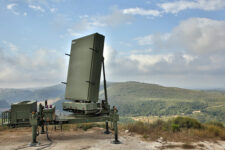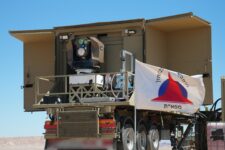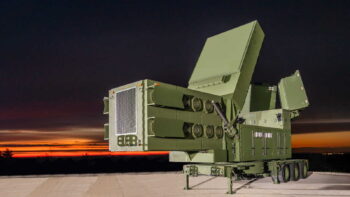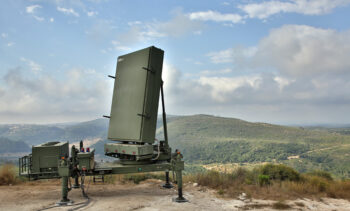
Gen. John Hyten (left) and Gen. Jay Raymond (left)
WASHINGTON: An ambitious plan that could fundamentally change how DoD develops, buys and uses satellite communications is complete and awaiting signature by Air Force Space Command’s Gen. Jay Raymond. It will be accompanied by a classified strategy that identifies next steps and timelines for implementing the so-called SATCOM Enterprise, AFSPC tells Breaking D.
AFSPC’s SATCOM Vision is aimed at creating a seamless network of military and commercial comsats in all orbits, accessible to troops, vehicles, ships and aircraft via ground terminals and mobile receivers that would automatically “hop” from one satellite network to another.
Raymond, double-hatted as commander of Air Force Space Command (AFSPC) and the new Space Command (SPACECOM), may yet decide to make changes before the new AFSPC “vision” is released, AFSPC said in an email. Still, the news should hearten SATCOM industry officials. Commercial providers have been agitated about what they have seen as a lot of talk, but little action by DoD to better integrate commercial satellites into DoD’s SATCOM architecture.
“There has been a lot of frustration,” said one senior industry source told Breaking D earlier this week.
To push things along, commercial firms have been lobbying Congress to provide fiscal year 2020 and 2021 funding for “commercial SATCOM integration” with military satellites and systems. Congress appropriated $49.5 million in 2019 to chivy the Air Force along with reforming how it buys commercial bandwidth, transferring the money from the Wideband Global Satcom (WGS) system. DoD did not, however, ask for 2020 funding for the effort, which was “very disappointing,” one industry source said.
“That did not match the signals we have been getting from the Air Force and DoD leadership about accessing commercial capabilities,” the source said. “We are hoping for FY21, and getting back on track — industry continues to work with Congress on it.”
AFSPC explained that today’s “SATCOM enterprise is a loose federation of stove-piped SATCOM systems operated and controlled by multiple organizations. Tomorrow’s enterprise must constantly evolve to adapt to emerging threats, adopt new private sector capabilities, and use agile acquisition methods to quickly deliver capabilities needed by the warfighter. This includes the possible inclusion of commercial LEO [Low Earth Orbit] and MEO [Medium Earth Orbit] SATCOM systems that show promise for augmenting our existing and planned SATCOM capabilities.”
Terminals are actually the long pole in the tent for any future hybrid SATCOM architecture, government and industry sources explain. There have been chronic problems ensuring that terminals for DoD’s own satellites are available when satellites make it into orbit. For example, explained an industry source, the Navy’s Mobile User Objective System (MUOS) network of Ultra-High Frequency (UHF) narrowband satellites “has been up there for three or four years waiting for a more advanced terminal to talk to it.”
To enable users to “roam” seamlessly among available SATCOM networks to find the best connection, terminals and antennas have to be capable of catching signals from multiple orbits and be able to function across the spectrum bands used by satellite systems — L-band, Ka-band, Ku-band, etc. And development of such advanced terminals is technically challenging.
“Those terminals do not exist,” a senior industry source said bluntly.
Introducing multi-mode terminals and receivers into the field is complicated by the fact that the Air Force isn’t the only service buying them. The Army (the biggest user of space), the Navy, and even operational component commands such as Special Operations Command, buy their own.
Indeed, industry and government sources said, one of industry’s biggest concerns as the AFSPC effort has chugged along over the last 18-plus months is that there has been a lack of input from the rest of the DoD SATCOM user community. AFSPC, however, says it recognizes the need to coordinate.
“AFSPC must reach out and work with the other services to ensure an integrated enterprise,” AFSPC said in response to questions from Breaking D. In addition, “AFSPC must prove the benefits of an integrated enterprise through prototypes and demonstrations. For example, the successful demonstrations of a flexible modem interface supporting multi-band, multi-waveform agile operations for user terminals were completed this past February and generated a great deal of positive interest. We believe more collaborative efforts will show the value of making terminals flexible and services’ terminal offices will modify their terminals in order to receive more capability and resiliency for their respective users.”
AFSPC’s effort to draft the SATCOM vision was a follow-on to the “Space Enterprise Vision” put together back in 2018 by then-STRATCOM Commander Gen. John Hyten and Raymond. (Hyten recently was confirmed as Vice Chairman of the Joint Chiefs of Staff.) The hybrid architecture concept was first briefed to industry at STRATCOM in December 2018. An industry day was held this Valentine’s Day that included representatives from most of the major comsat providers, including Hughes, Inmarsat, Intelsat, Iridium, SES, and ViaSat.
In the meantime, DoD and the Air Force have been caught up in a plethora of organizational changes that affect who does what and when with regard to SATCOM.
These include the stand up of the new Space Command (SPACECOM) on Aug. 29, and the so-called “2.0” reorganization of the Air Force’s acquisition unit, Space and Missiles Systems Center (SMC).
Key to all this, SPACECOM is creating a new SATCOM Integrated Operations Division, Brig. Gen. Tom James, now the head of SPACECOM’s Joint Task Force Space Defense, told the Space and Missile Defense Symposium in Huntsville Aug. 6. The new division, he said, would “look across global satcom requirements” and study “plans for satcom support for geographical combatant commands,” in order to “look for gaps,” assess threats (such as adversary jammers) and figure out how to “fight through” a degraded space environment.
Finally, at the instruction of Congress in the 2018 NDAA, the Defense Information Systems Agency (DISA) officially transferred responsibility for leasing commercial SATCOM to AFSPC in December 2018.
The latest version of the AFSPC’s draft was shared with industry in March, along with a request for industry comment and suggestions. AFSPC’s Enterprise Strategy and Architecture Office (ESAO) is responsible for completing the final changes. The broad goal of the vision is to provide affordable, resilient and secure SATCOM that can rapidly adapt by injecting new technologies to meet changing threats.
One of the key concepts underlying the vision, according to a draft obtained by Breaking D, is to “fight” SATCOM as an “integrated enterprise” under a single commander. Of course, that is likely to make every commercial satellite provider a target in the event of war, an issue the Air Force is just beginning to address.
The draft explains that currently, no one has the ability to centrally manage leases of commercial satcom — something that would allow better efficiency. It states that “coordination of all SATCOM” requirements, planning, allocation and operational management under Raymond would “responsively allocate and re-provision SATCOM resources (military, commercial, and coalition systems), automatically move or restore the highest priority users in times of degraded service or conflict, resolve electromagnetic interference (EMI), conduct crisis planning, and reconfigure the enterprise to optimize when resources are lost.”
The other three foundational concepts are:
- “dynamically optimize access” for users;
- improve resiliency and functionality in degraded environments;
- rapidly field new SATCOM capabilities to support “agile” operations.
But the vision itself isn’t the only thing that is needed, industry representatives say. A concept of operations is required for how the Air Force intends to manage different user needs and interact with different industry providers. “The vision is out, but there is no concept of operations,” said one source.
AFSPC explains that “to deliver the ‘Fighting SATCOM’ effects to the warfighter, the enterprise is dependent not only on terminals capable of multi-band, multi-waveform operations, but also dependent on an Enterprise Management and Control (EM&C), coupled with flexible networking and diverse and proliferated space segment capabilities. Collectively, these capabilities support path diversity to prevent an adversary from shutting down a mission by denying a single satellite.”
AFSPC acknowledges that, it “must deliver an integrated enterprise supported by a responsive command and control structure to give the USSPACECOM commander the situational awareness he requires, from SATCOM resource allocation on any system to any DoD user at any time, to the ability to automatically move and restore the highest priority users in times of degraded service or conflict.”
Although DoD did not ask for 2020 funds specifically for commercial SATCOM integration, AFSPC said that there were requests for support of various programs aimed at the wider goal of a hybrid architecture. “Funds were requested to mature and build upon our previous flexible modem interface (FMI) successes supporting users’ terminals, but there were many needs within last year’s budget cycle across many mission areas that needed to be addressed as well,” AFSPC said. “However, money for portions of an SATCOM EM&C capability were supported in AFSPC’s budget.”
For example, Hughes last month was awarded a $2.2 million contract, through the service’s Space Enterprise Consortium (SpEC), to produce and demonstrate an Enterprise Management and Control (EM&C) prototype. It will be based on the Hughes Flexible Modem Interface (FMI), which will “enhance interoperability across military and commercial SATCOM networks to form a unified hybrid network architecture,” according to a Sept. 16 company press release.
Iridium, which has a special public-private partnership with DoD, announced on Sept. 16 that AFSPC had inked a $738.5 million, seven-year, fixed-price contract to extend access to Iridium’s 66-satellite network under the Enhanced Mobile Satellite Services (EMSS) program. A company official explained that the EMSS is a “stand alone” program that has provided Low Earth Orbit-based tactical SATCOM for DoD users for nearly 20 years, and that the seven-year contract is an effort by DoD and the company to find greater efficiencies. The EMSS program now has more than 125,000 DoD subscribers.
While avoiding Breaking D’s direct question about 2021 funding, AFSPC did say: “More funds are needed to deliver a fully operational, integrated enterprise, for all components of the enterprise.”
On top of all this, commercial SATCOM industry reps have been fretting about the relationship of the AFSPC vision and the nascent Space Development Agency, managed by DoD research and development czar Mike Griffin. In particular, industry is nonplussed about SDA’s change in focus from looking to commercial providers to deciding to build its own “transport layer” of interlinked satellites for connecting sensors and shooters on the ground and in space.
This “backbone” communications network is the linchpin of SDA’s ambitious National Space Defense Architecture, new SDA director Derek Tournear told reporters in mid-September at the 2019 Air Force Association conference. According to a comprehensive overview of the budget plan by colleague Sandra Erwin, SDA intends to ask for $16 million in 2021 and $3.6 billion over the next five years — out of a total five-year budget request of a whopping $11 billion. The plan is to launch some 20 satellites in 2022, with a final configuration of 250-plus on orbit by 2025.
“It’s very important that SDA clearly define its mission,” said one industry representative. “What are they doing, and what is the role for commercial services versus traditional contracts?”
AFSPC, for its part, says that “SDA is responsible for advancing technologies and capabilities that are not available to our warfighter today. AFSPC will need to work closely with SDA to ensure any additional SATCOM capability acquired by SDA can ideally be folded in to the larger integrated hybrid enterprise, adding resiliency to the overall enterprise and delivering more agility to the warfighter.”


























